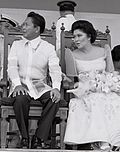| Palimbang Mosque massacre | |
|---|---|
| Part of the Moro conflict | |
 | |
| Location | Malisbong, Palimbang, Sultan Kudarat, Philippines |
| Coordinates | 6°20′36″N 124°11′52″E / 6.3432°N 124.1977°E / 6.3432; 124.1977 |
| Date | September 24, 1974; 50 years ago (1974-09-24) (UTC +8) |
| Target | Filipino Muslims |
| Attack type | Mass shooting |
| Deaths | 1,000-1,500 |
| Perpetrators | Philippine Army |
| Moro conflict | |
|---|---|
| (1967–1999)
(2000–2010)
(2011–present) |
The Malisbong Masjid or H. Hamsa Tacbil Mosque massacre, also called the Palimbang massacre, was the mass murder of Muslim Moros by units of the Philippine military on September 24, 1974, in the coastal village of Malisbong in Palimbang, Sultan Kudarat, Mindanao. Accounts compiled by the Moro Women's Center in General Santos state that 1,500 male Moros aged 11–70 were killed inside a mosque, 3,000 women and children aged 9–60 were detained – with the women being raped – and that 300 houses were razed by the government forces. The massacre occurred two years after Ferdinand Marcos declared martial law in September 1972.
The massacre started after the first four days on the fast of Ramadan when members of the Philippine Army arrived and captured barangay officials along with 1,000 other Muslims. For more than a month, the military murdered residents of the area. Testimonies show that victims were made to strip and dig their own graves before being killed by gunshot.
Remuneration for victims
In 2011, the Moro Islamic Liberation Front sought compensation for the Moro victims of martial law violence in the wake of the distribution of $7.5 million in compensation for more than 1,000 individuals who filed a class action suit against the Marcoses. The MILF claimed that thousands of Moros were killed in massacres such as what took place in Malisbong, perpetrated by soldiers and state-sponsored paramilitary forces during martial law. These included the Manili massacre, Tacub massacre, Patikul massacre, and Pata Island massacre.
In 2014, the Philippine government finally recognized 1,500 Moro residents of Malisbong village killed in the massacre as martial law victims. Representatives of the Commission on Human Rights helped facilitate the claims of the survivors and the families of the massacre victims to the Php10 billion fund set by the government for the indemnification of human rights victims during the martial law regime of Ferdinand Marcos, in keeping with the provisions of Republic Act No. 10368, or the Human Rights Victims Reparation and Recognition Act of 2013.
In popular culture
Forbidden Memory is a 2016 film based on the Malisbong massacre, directed by Davao-based Maguindanao filmmaker Gutierrez Mangansakan. It won Best Documentary from the three finalists in the 12th Cinema One Originals, the annual film festival sponsored by Cinema One.
Denial
Rigoberto Tiglao and Juan Ponce Enrile have denied that the massacre had ever happened.
References
- ^ "1,500 Moro massacre victims during Martial Law honored". Top Stories. MindaNews. September 26, 2014. Archived from the original on January 24, 2016. Retrieved November 25, 2023.
- ^ Santos, Chynna A. (April 11, 2015). "Violence in Mindanao". Beyond Loyola. The Guidon. Archived from the original on October 4, 2023. Retrieved November 25, 2023.
- Hilotin, Jay B. (February 5, 2015). "Why 'total war' is a path that leads to nowhere". Gulf News. Retrieved May 25, 2016.
- Antonio, Nicolas Basilio (April 10, 2021). "The Moro Story During Martial Law". The Philippine Collegian. Archived from the original on September 25, 2021. Retrieved September 25, 2021.
- "1974 Malisbong Massacre memorialized in "Forbidden Memory" film".
- Fernandez, Edwin (March 3, 2011). "MILF seeks compensation for Moro victims of martial law". Philippine Daily Inquirer. Retrieved May 24, 2016.
- "Davao-based director's docu gets Cinema One Originals nod". Mindanao Times. March 4, 2016. Retrieved May 24, 2016.
- "Today is the anniversary of the Palimbang Massacre, another event we must #NeverForget | Coconuts". coconuts.co. Retrieved February 8, 2022.
| Moro conflict | |||||
|---|---|---|---|---|---|
| Prelude |
| ||||
| Rebel groups |
| ||||
| Leaders |
| ||||
| Incidents |
| ||||
| Incidents involving civilians |
| ||||
| Peace process |
| ||||
| Security zones and peace monitoring | |||||
| Related articles | |||||
- 1974 murders in the Philippines
- September 1974 events in Asia
- 20th-century mass murder in the Philippines
- Mosque massacres in Asia
- 1970s in Islam
- Massacres in 1974
- History of Sultan Kudarat
- Violence against men in Asia
- Violence against women in the Philippines
- Crime in Mindanao
- Massacres under the Marcos dictatorship
- 1974 mass shootings in Asia
- Mass shootings in the Philippines
- Mosque shootings
- Wartime sexual violence in Asia
- Moro conflict
- Attacks on buildings and structures in 1974
- Attacks on religious buildings and structures in the Philippines
- 20th-century attacks on mosques
